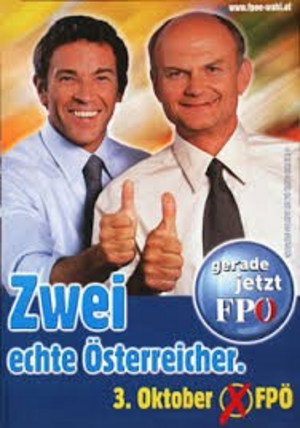
National Council election 1999
At the National Council election of 3 October 1999, Thomas Prinzhorn served as the FPÖ’s lead candidate, sharing the limelight with Jörg Haider, who was ranked second on the party’s candidate list. The FPÖ won 26.91 per cent of the vote (an increase of 5.02 percentage points), which constitutes the best National Council result in the party’s history. That translated into 52 National Council seats, an increase of 11.
The losses suffered by the SPÖ were again severe. Those of the ÖVP were modest and it dropped into third place, just behind the FPÖ. The Greens were able to increase their vote, while the Liberal Forum was unable to re-enter the National Council.
Brief description of the election campaign
The SPÖ held the chancellorship for nearly three decades. In Austria, the public mood for change had reached a peak and as at the preceding elections, the FPÖ was able to fully commit to playing the card of renewal. The FPÖ presented its two lead candidates, Thomas Prinzhorn and Jörg Haider – who was not the sole lead candidate, because he had in the preceding spring become Governor of Carinthia - as “two genuine Austrians”. The main slogan was “Österreich zuerst” (“Austria First”), which appeared alongside either “Wir garantieren: Stopp der Überfremdung!” (“We guarantee: an end to foreign infiltration!”), or “Wir garantieren: Stopp dem Asylmissbrauch!” (“We guarantee: an end to asylum abuse!”). Haider and Prinzhorn were also depicted alongside slogans such as “Echte Freunde halten ihr Versprechen” (“True friends keep their promises”).
The slogan “Austria First” was chosen to build on the eponymous popular petition which the Freedom Party had conducted in 1992. The topic of immigration was merely one of many, however; the main aim was to break open the system of red-black “Proporz” (i.e. SPÖ-ÖVP distribution of posts and resources) and Austria’s encrusted political structures – keyword: party patronage and cronyism (Parteibuchwirtschaft) - but also to drive forward the denationalisation of many sectors.
Election result
The following parties and electoral lists, among others, stood for election at the National Council election of 1999:
Sozialdemokratische Partei Österreichs (SPÖ)
Österreichische Volkspartei (ÖVP)
Freiheitliche Partei Österreichs (FPÖ)
Die Grünen – Die Grüne Alternative (GRÜNE)
Liberales Forum (LIF)
Die Unabhängigen – Liste Lugner (DU)
Kommunistische Partei Österreichs (KPÖ)
Nein zu NATO und EU – Neutrales Österreich Bürgerinitiative (NEIN)
Christliche Wählergemeinschaft (CWG)
Parties | Votes | Vote share 1999 | ± | Seats 1999 | ± |
SPÖ | 1,532,448 | 33.15% | -4.9% | 65 | -6 |
FPÖ | 1,244,087 | 26.91% | +5.02% | 52 | +11 |
ÖVP | 1,243,672 | 26.91% | -1.38% | 52 | ±0 |
GRÜNE | 342,260 | 7.40% | +2.59% | 14 | +5 |
Government formation
The losses suffered by both governing parties (and especially by the SPÖ) made a change of government possible. The SPÖ’s attempts to negotiate a coalition failed. The coalition negotiations between the ÖVP and FPÖ were successful, even though they led to the chancellorship being secured by the ÖVP, the third-strongest party. Schüssel I (that is to say, the Federal Government led by ÖVP Federal Chancellor Wolfgang Schüssel) was a “coalition of change”. It constituted the first-ever black-blue government and brought an end to almost 30 years of SPÖ chancellorships. The FPÖ’s participation in government led to fierce international protests and to EU sanctions, which were lifted in September 2000, in line with the recommendations of a “Council of Wise Men”.
